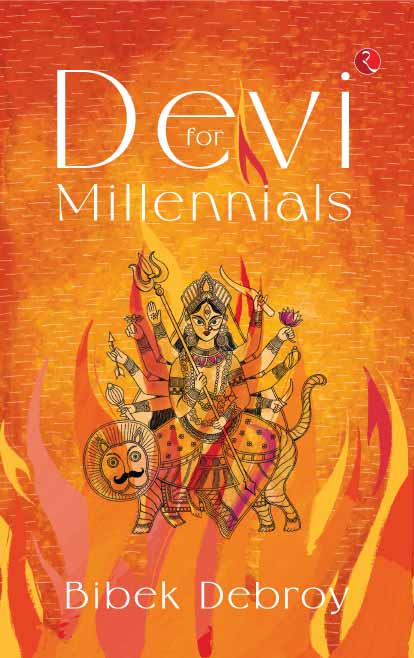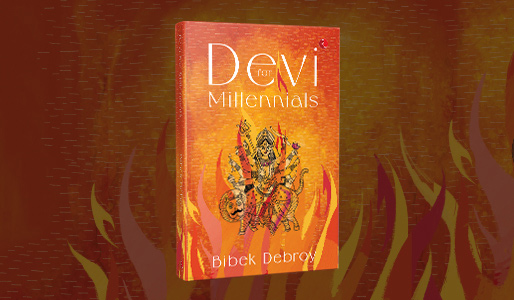Devi For Millennials: Excerpt
DAKSHA’S YAJNA, SATI, SHAKTI PEETHAS AND PARVATI

As I said earlier, Devi’s story doesn’t feature only in the Markandeya Purana. One of her most familiar stories is probably about Daksha’s yajna or sacrifice.1 Just as the major Puranas are the Mahapuranas, there are also Upapuranas, which are minor Puranas. The story of Daksha’s sacrifice and how Sati gave up her body has been recounted in many Mahapuranas and Upapuranas, with minor variations in details. I will narrate the version from Shiva Purana, which is a Mahapurana, since it has an interesting twist. The story comes from a section in the Shiva Purana called Sati Khanda, the section about Sati. In the cycle of creation and destruction, everything was destroyed. When it was Brahmaa’s day again, and a new kalpa began, he wished to create the various worlds again. Initially, Brahmaa begot sons through his mental powers. These were the Prajapatis, who were known as such because they were engaged in the task of creation. Daksha was a Prajapati who had several daughters. According to the Shiva Purana, Daksha prayed to Devi, who blessed him with another daughter—Sati. Since she was Daksha’s daughter, she was also known as Dakshayani.
Sati was married to Shiva. However, going back to the twist I had mentioned at the beginning of the chapter, before their marriage, Shiva told Brahmaa and Vishnu that he had taken a pledge: if his wife ever distrusted him, he would desert her. With this pledge, Shiva married Sati. On one occasion, Shiva and Sati saw Rama wandering around in the forest, along with Lakshmana, searching for Sitaa, who had been abducted by Ravana. Seeing them, Sati asked Shiva, ‘Who is this person?’ When Shiva said that this was Rama, Vishnu’s avatara, Sati refused to believe him. She put Rama through a test, and Rama passed. But since Sati had distrusted her husband’s words, her separation from Shiva was inevitable.
The Great Yajna
Daksha did not like his son-in-law, Shiva. According to him, neither did Shiva possess any of the desirable attributes a son-in-law should, nor was Shiva sufficiently deferential towards him. For example, Shiva did not bow down before Daksha. Hence, when Daksha performed a yajna (sacrifice), he didn’t invite Shiva. All the other devas were invited, and Sati’s sisters also turned up. From Mount Gandhamadana, Sati saw everyone travelling through the sky, going to Daksha’s yajna. Despite Shiva wishing to restrain her, Sati decided to go, even though they had not been invited. ‘Since when does one need an invitation to go to a father’s house?’ she argued. However, Daksha abused her and her husband. This was impossible for Sati to tolerate. She immersed herself in yoga and gave up her life. The fire that emerged from within her body burnt her down. Hearing that Sati had died, Shiva was enraged. From a strand of his matted hair, he created Virabhadra and Mahakali, and sent them to the sacrificial area. These two destroyed Daksha’s sacrifice.
The Four Shakti Peethas
Most people know the even more popular story of the Shakti Peethas. Peetha(ihB) means seat or pedestal, and a Shakti Peetha is a spot that is sacred to Devi or Shakti. The story of the Shakti Peetha is connected to Sati’s death at the time of Daksha’s sacrifice, and is recounted in the Kalikaa Purana, which is an Upapurana. In this version of the story, when Sati died, the dead body was not reduced to ashes. Grief-stricken, Shiva picked it up and carried it on his shoulders, rushing helter-skelter. Seeing this, Brahmaa and the other devas were devastated and worried about what would happen. Since Sati’s dead body was on Shiva’s shoulders, there was no question of it decaying or falling off. Brahmaa, Vishnu and Shanaishcara (Shani or Saturn) used the powers of yoga and entered Sati’s dead body. Subsequently, they cut it into many parts and scattered them around the earth. According to the Kalikaa Purana, this wasn’t done by Vishnu alone. Because of his love for Sati, in the form of a lingam, Shiva remained at the spots where parts of Sati’s body fell. Which were these places? The Kalikaa Purana mentions four. One should remember that each Mahapurana or Upapurana was composed in a certain part of the country, and, therefore, favours that part of the country over others. The Kalikaa Purana favours the eastern parts, such as the Kamarupa–Kamakhya region, especially associated with Devi worship. These are the three relevant slokas from the Kalikaa Purana in the context of this story. These texts have different manuscripts and versions that don’t necessarily agree. I have quoted from my text of the Kalikaa Purana.
First, the two feet fell down on earth in Devikuta. Thereafter, for the welfare of the worlds, the two thighs fell down in Uddiyana. The part around the vagina fell to the earth in Kamarupa, on the mountain Kamagiri. The region around the navel also fell there. The two breasts, adorned with a golden necklace, fell in Jalandhara. Beyond the region of Kamarupa, the shoulders and neck fell in Purnagiri. Where are these geographical places? This question will be addressed in a more comprehensive listing that comes later. For now, it is sufficient to note that traditionally, there are four peethas, known as Vidya Peetha, Mantra Peetha, Mudraa Peetha and Mandala Peetha. Vidya Peetha, as the name suggests, is a peetha associated with knowledge and learning. In particular, these were places where Agama texts were studied. Agamas are texts other than the Vedas, such as the tantra texts. Vidya Peetha has been identified in Kamarupa, that is, Kamakhya, which is, of course, in the Nilachal hills in Guwahati. Mantra Peetha is a peetha associated with mantras and is said to be located in Purnagiri, which is the Devi temple in Tanakpur in Uttarakhand. A place where Devi is particularly worshipped for the use of mudraas—symbolic and mystical positionings of the fingers and the thumb—is known as Mudraa Peetha. It is said to be located in Uddiyana, which is also known as Oddiyana. This place has been impossible to precisely locate. It might be in Odisha or in what is now Pakistan. That leaves Mandala Peetha, a place where Devi is especially worshipped through the use of mandalas—mystical diagrams. Mandala Peetha is said to be located in Jalandhara.
The Devi Purana and More Peethas
Besides these four Shakti Peethas, there are many more. Where do those names and those lists come from? To understand that, I have to say a few things about the Mahapuranas.The 18 Mahapuranas have been mentioned in many texts, though their names sometimes vary. A standard list of the 18 includes: (1) Agni; (2) Bhagavata; (3) Brahma; (4) Brahmanda; (5) Brahmavaivarta; (6) Garuda; (7) Kurma; (8) Linga; (9) Markandeya; (10) Matsya; (11) Narada; (12) Padma; (13) Shiva; (14) Skanda; (15) Vamana; (16) Varaha; (17) Vayu; and (18) Vishnu. The Markandeya Purana is, of course, a part of the list. The second Purana, the Bhagavata Purana, has been the subject of some contention. But what does Bhagavata Purana mean? There is no qualifying adjective attached to the name. The devotees of Vishnu argue that Bhagavata Purana means the Purana that expounds Vaishnava dharma and has stories about Vishnu, also known simply as Bhagavatam. However, Devi’s devotees say that Bhagavata Purana means Devi Bhagavata Purana. Indeed, if one wishes to understand Devi and her worship, in addition to the Markandeya Purana and Kalikaa Purana, one must read the Devi Bhagavata Purana.3The Devi Bhagavata Purana is divided into sections, known as skandhas. Depending on the version of the text you are reading, the 30th chapter of the seventh skandha discusses Sati’s birth as Daksha’s daughter and Daksha’s yajna. In the version of the story in this text, Sati gave up her body at the time of the yajna. Miserable, Shiva wandered around, carrying her dead body on his shoulders, which agitated Brahmaa and the other devas. The Devi Bhagavata Purana tells us that Vishnu (there is no mention of Brahmaa or Shani) cut the body into pieces. It is believed that Vishnu did this with his chakra. According to the Devi Bhagavata Purana, however, Vishnu did this with his bow and arrows. Shiva, of course, stayed in the spots where Sati’s body parts were scattered, in the form of a lingam. The Devi Bhagavata Purana gives us a list of these places and describes them as Siddha Peethas. Sometimes, the expressions Siddha Peetha and Shakti Peetha are used synonymously, as with the Devi Bhagavata Purana. Other times, a distinction is drawn between the two. A Siddha Peetha is a place where one or more sadhakas have obtained siddhiin their sadhana. It may or may not be a Shakti Peetha. In contrast, a Shakti Peetha is a place where a part of Sati’s body fell. The Devi Bhagavata Purana, along with each location, mentions a name or form of Devi associated with it. Except for Varanasi, where Devi’s face is said to have fallen, other locations do not mention a specific body part of Devi falling there. The number 108 is, of course, sacred and it is natural for such a list to have 108 Shakti Peethas. The Padma Purana has a similar list. We are also told that, under the name of Brahmakalaa, Shakti exists in the consciousness of all those with bodies. In the text, this entire account is recited by Vedavyasa to King Janamejaya. Vedavyasa concludes by saying, ‘O Janamejaya! I have recounted the names of 108 peethas to you, the directions in which these exist and the names of Devi there. These Peethas are said to have originated because of Devi Sati’s body parts. They exist on the surface of the earth and elsewhere too.’ The popular belief is that there are 51 Shakti Peethas. So, you may be surprised to learn that a revered text like Devi Bhagavata Purana mentions 108 Shakti Peethas.
The notion of Shakti Peethas evolved over time, and the numbers changed from four to 18 to 51. Tantra texts of much later vintage, say written 500 years ago, also discuss the Shakti Peethas. The Tantrachudamani,for example, has a section on the determination of peethas. It has a section where Devi herself speaks about 51 Shakti Peethas, the parts of her body that fell down after being severed by Vishnu’s chakra, and the Bhairava (Shiva) who has, since, established himself in these places. However, this is merely one list according to one text. Our perceptions about Shakti Peethas, including the belief that Sati’s body was severed by Vishnu’s chakra, come from this text. Note that tantra texts, like this one, are the first time we find a specific mention of a part of Sati’s body associated with a place. Note also that while Devi has a name associated with each location from this text, it also mentions an associated name of Bhairava.
While most Shakti Peethas are located in present-day India, some are in Bangladesh, Nepal, Pakistan and perhaps even Sri Lanka. They naturally tended to be concentrated in places known for Shakti worship, such as Birbhum and Bardhaman districts of West Bengal, parts of Bangladesh and Nepal. I am not going to quote the Sanskrit text. That’s unnecessary.
Read more in Bibek Debroy’s #DeviForMillennials here: https://amzn.to/3C6371B

